Plain and simple, air travel is bad for the environment. The airline industry uses billions of gallons of gasoline yearly, but Southwest Airlines is trying to change all that. While airlines operate in a fashion that generates millions of tons of waste material and CO
2, Southwest Airlines uses green economics to promote its business and reduce the damage done by said business. While people like Elaine Karnes, Southwest Airlines’ Director of Environmental Services, are trying to mitigate all negative environmental effects, the
Environment Protection website has an article that informs us of the following:
[No] airline recycles all the major recyclables: aluminum cans, glass, plastic, and paper. No airline has a comprehensive program for minimizing or composting food waste or waste from snack packages, provides good public information about their recycling program, or reports out on progress in relation to any stated goals. In addition, all airlines provide over-packaged snacks and meals and none of the airlines are working with manufacturers to reduce this waste.
Published February 23, 2010, this article was based on a report from
Green America, an environmentally focused consumer watchdog organization. This group uses shock and awe to stun anyone reading the report. The first line reads, “Airline passengers create 881 million pounds of waste per year (half of it in flight), and much of it is not recycled.”
With such staunch opposition, it is a surprise that Karnes has done so well promoting sustainable practices within her company. While Southwest Airlines ranked as the fourth most eco-friendly airline behind Delta, Virgin America and Virgin Atlantic in Green America’s study, it has been the impressive work of Karnes that has developed her company into one that is widely known as an advocate for green business. After doing a little research, it seems that the work of Southwest Airlines alone calls into question several of the accusations stated above.
The
Southwest Airlines website includes hard data to support the sustainable practices the company has undertaken in the last several years. What is of particular interest is the “Recycling and Waste Reduction” section that offers another way in which Southwest is redefining its industry.
In one year, Southwest Airlines had recycled 455.1 metric tons of materials, including 217.8 metric tons of cardboard, plastic, paper and aluminum; 118.3 metric tons of batteries; 106.6 metric tons of electronics; 11.8 metric tons of filters, liquid and solid paint waste and more. And, starting in April 2008, Southwest officially adopted a “Select-a-Snack” policy that, “[has an] annual net reduction of 750 million square inches, or 700,000 pounds, of waste material.”
So, where does this leave us? If all of these forward-thinking procedural changes have diverted nearly 1 million pounds of material from our landfills annually, then Southwest Airlines is doing a pretty good job leading the charge toward going green in one of the world’s most non-eco-friendly industries. And, now that I think about it, with the constant pursuit of energy and operational efficiency, recycling and smarter business, it seems that the only way the company could get greener is if planes ran on pollution. Keep in mind that air travel is perhaps the world’s best example of public transportation, but there is still much work to be done.
